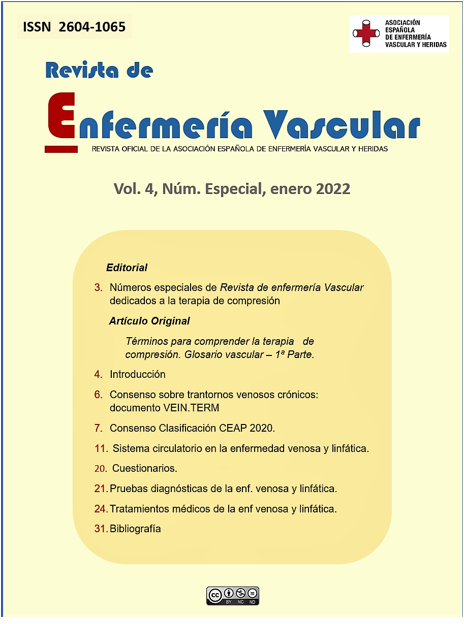Abstract
In January 2022, Revista de Enfermería Vascular celebrates its fourth birthday by launching the first of a series of special issues that will be devoted exclusively to dissecting what is the cornerstone of the approach to patients who suffer or may suffer from venous problems: compression therapy. Compression therapy for the treatment of chronic venous disease and lymphoedema is a readily available, non-invasive treatment option that is widely documented. However, there is a paucity of clinical trial evidence-based guidelines for the management of patients using compression therapy (1) and, unfortunately, its use is still not widespread in clinical practice. Furthermore, several studies (2) highlight the lack of patient adherence to compression therapy. After more than 15 years of continuous work as a nurse in a vascular surgery unit and, after 10 years of close collaboration with the AEEVH, I have been able to confirm that this subject continues to generate many doubts among nurses and doctors in all professional fields and, therefore, I am convinced that behind the reluctance of some professionals and the lack of adherence of many patients, there is, among other factors, a lack of knowledge and adequate specific training. In the absence of Clinical Practice Guidelines, a good way to increase knowledge is through reading scientific articles, and locating literature related to compression therapy is not difficult, as the main international bibliographic databases have coined descriptions that facilitate the task. The problem can arise when trying to critically read the articles found in order to assess their quality and applicability, or even when confronted with the technical specifications that appear in the documents provided by the industry. Understanding compression is no easy task. Understanding compression requires the study and assimilation of many anatomical, physiological, physiopathological, semiological, diagnostic and therapeutic terms and concepts. But, in addition, in order to be able to make an informed choice among all the alternatives available on the market, it is essential to know other concepts related to the physical properties of the tissues and materials used to make bandages, stockings and Velcro devices. The main objective that has led us to publish these issues has been to try to shed some light on these and many other aspects related to compression to help nurses and, of course, all those professionals who, in their day-to-day work, need to prescribe, give recommendations or apply compression therapy to their patients. And for this, from the very beginning, at Revista de Enfermería Vascular we were very clear that the best person to take on this challenge with rigour and quality guarantees was Carmen Alba Moratilla, a renowned wound specialist who has always been very committed to the training of other professionals in everything related to compression and who has been one of the main promoters of its use in Spain. For all these reasons, but also for her charisma, her leadership skills and her communication skills, she has become a national and international reference in this field. We are sure that, thanks to her, this series of special issues will be of interest to all our readers.

